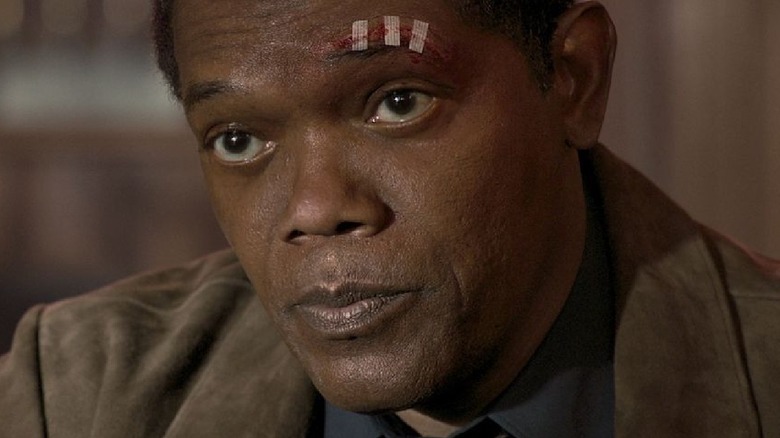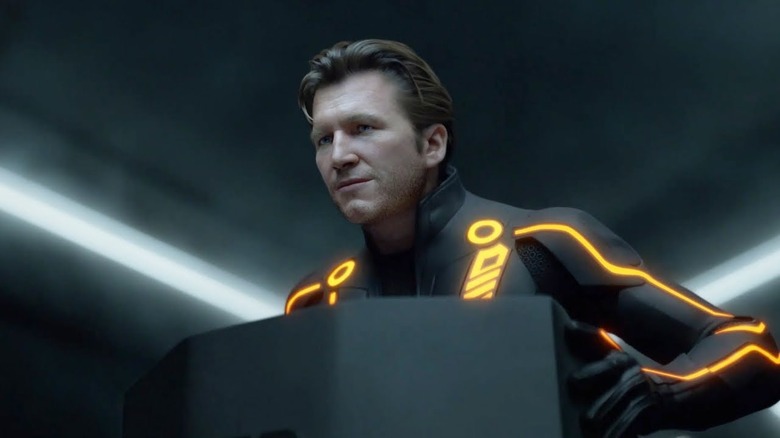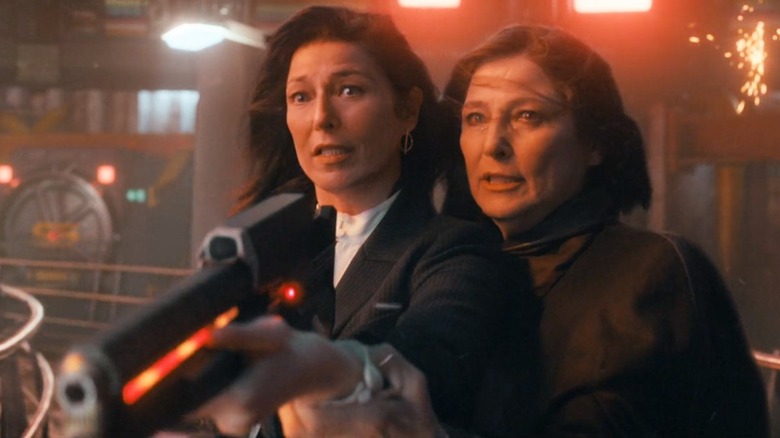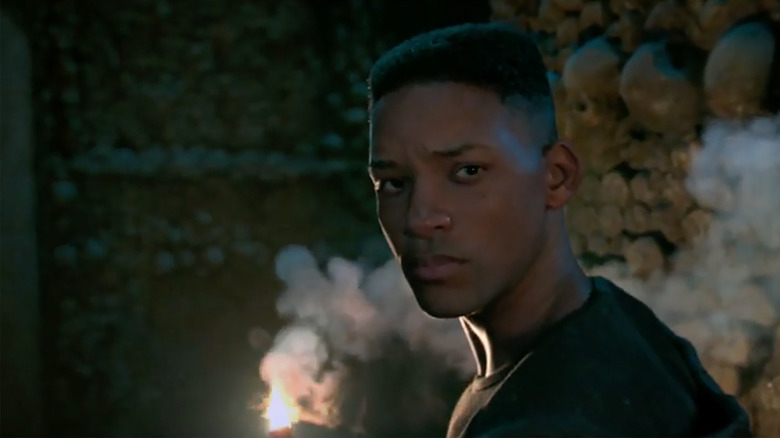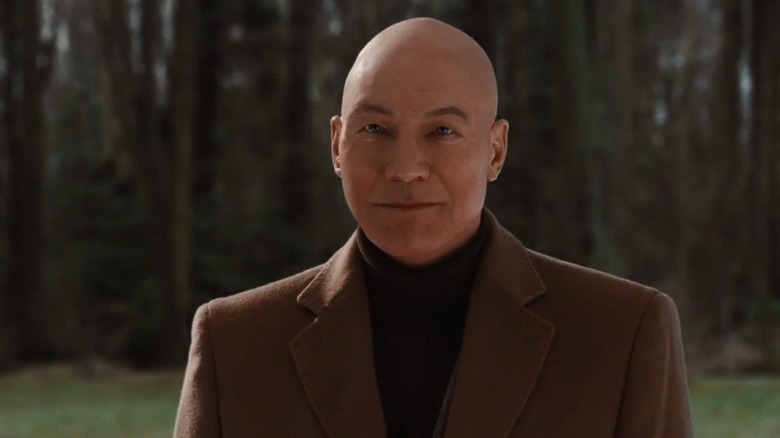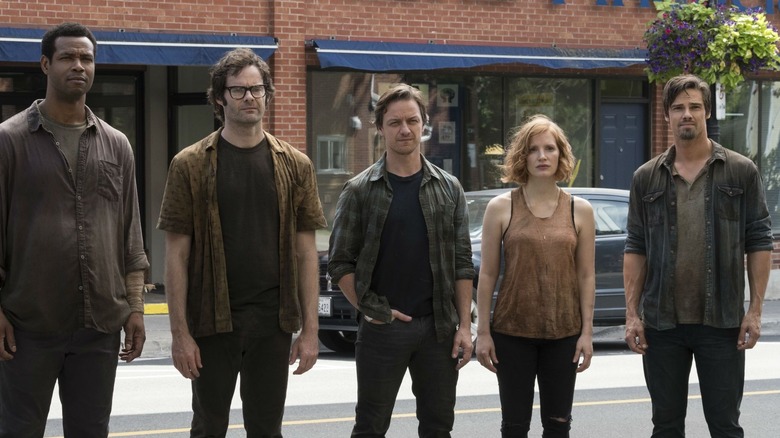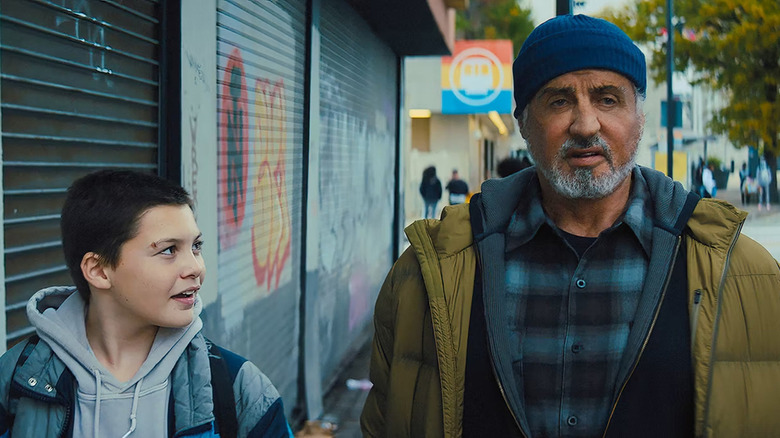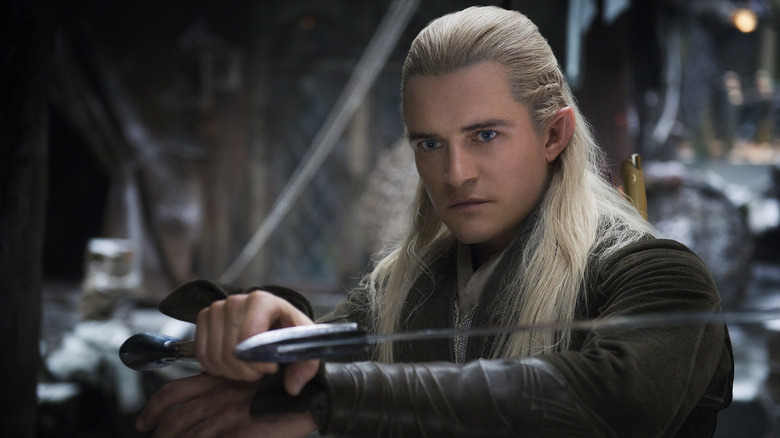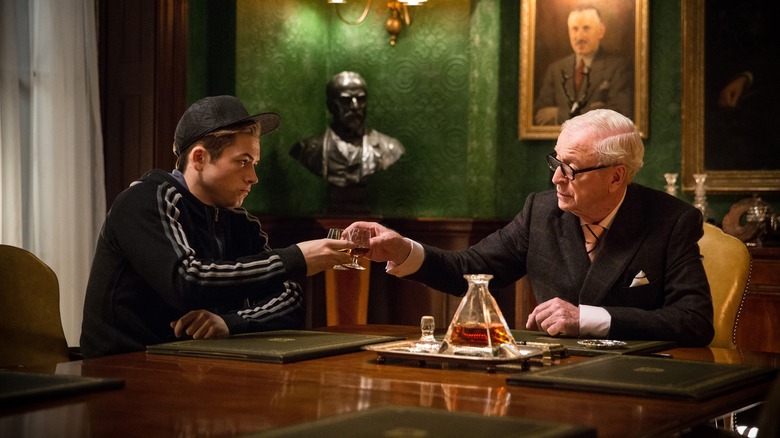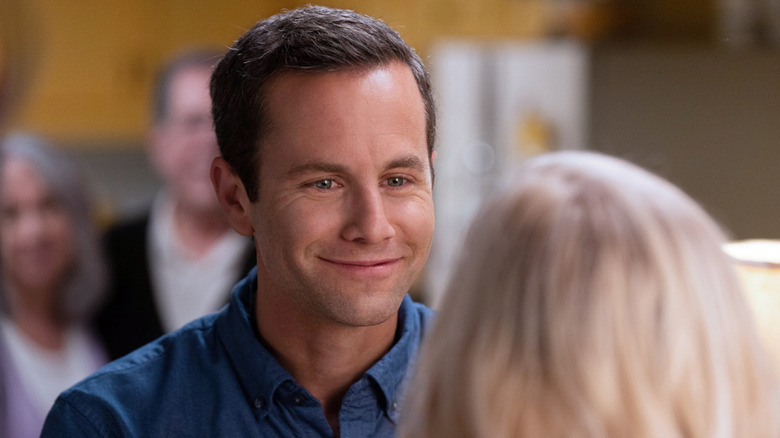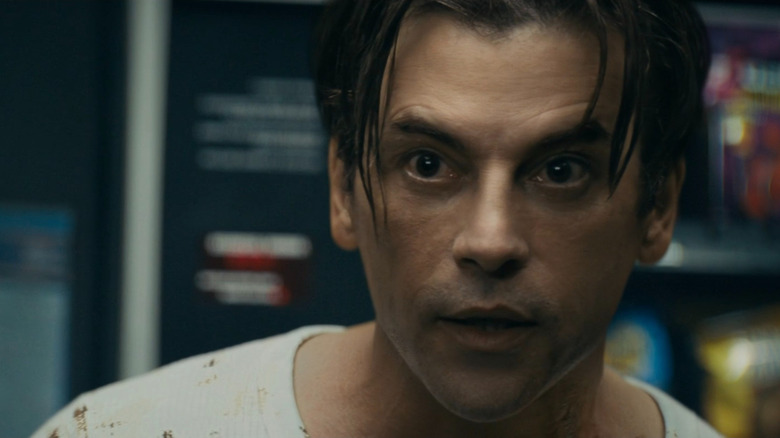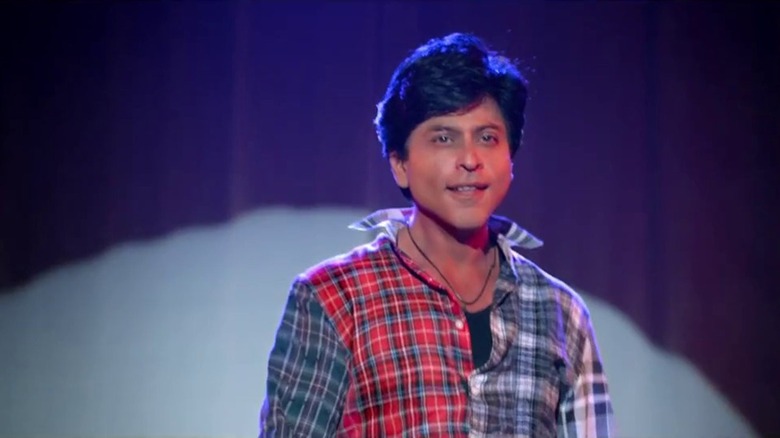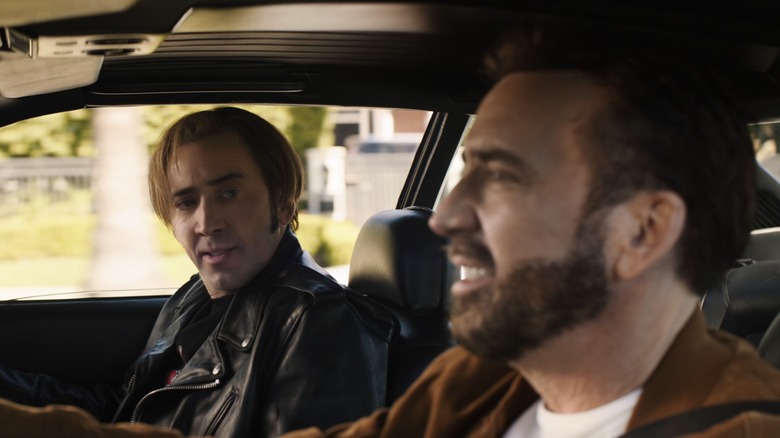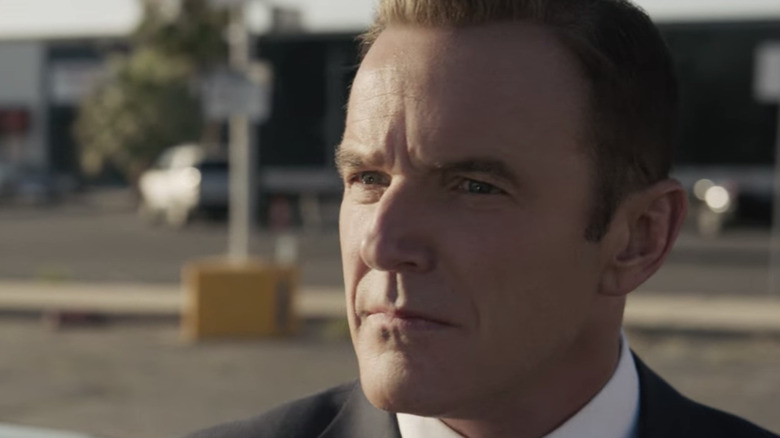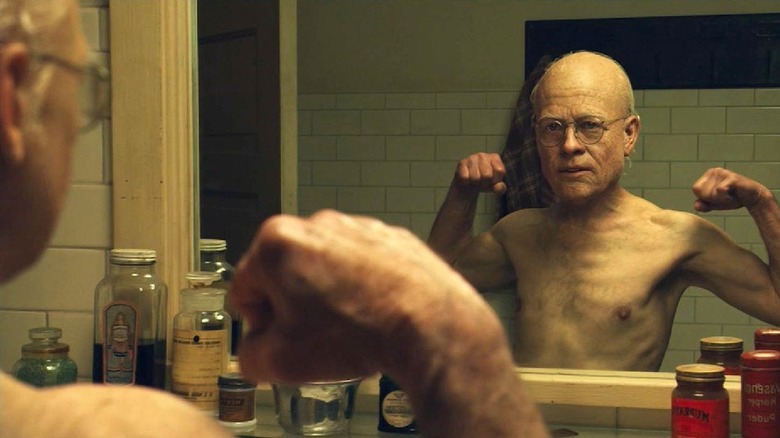15 Times De-Aging Technology Missed The Mark In Movies
The world of digital de-aging technology is an extremely enticing concept on paper. So many storytelling and visual possibilities open up if you can use modern-day visual effects wizardry to turn back the clock and make recognizable actors young again. Plus, in an age where nostalgia is king, making iconic movie stars look just like they did back in the 1970s and 1980s sounds like the perfect element to throw into the modern pop culture landscape. In some cases, digital de-aging has resulted in some truly extraordinary cinema, most notably in Martin Scorsese's "The Irishman." Unfortunately, no visual effects tool is foolproof, and the landscape of digital de-aging is no exception.
Over the years, there have been several examples of significant big-budget movies failing to deliver on all the promise digital de-aging has to offer. Rather than making convincing recreations of vintage movie stars, they've only made rubbery humans that remind everyone how easy it is for visual effects work to slip into the uncanny valley. The types of films that have housed these examples of digital de-aging have ranged wildly, from big blockbusters to horror features to even low-budget faith-based dramas. The genres may vary, but all these motion pictures provide eerie and uncomfortable demonstrations of the limits of digital de-aging technology.
Tron: Legacy
"Tron: Legacy" was strangely ahead of the curve on the 2010s blockbuster scene. It nailed down the storytelling mold of the typical legacy sequel a full five years before "Star Wars: The Force Awakens" hit theaters, while it also established just how rampant digital de-aging would become in big-budget American movies. Here, that technology was applied to Jeff Bridges, so that he could portray the villainous program Clu in addition to his fully live-action "Tron" character Kevin Flynn. With the latter figure now an old man in hiding, the digital youthfulness of Clu, on paper, should have made the character an eerie reminder of past mistakes and arrogance of yore.
Instead, all audiences could think about once Clu was up on the screen was how not right he looked. This digital approximation of young Jeff Bridges (also seen in an opening flashback sequence where a much younger version of Flynn is tucking his son in for the night) looked too much like plastic to come across as a viable person. This problem got only worse as "Legacy" went on and tried to wring serious moments of tension or dramatic weight out of such a hollow-looking creation. This aspect of Clu couldn't even be chalked up to the character living in a virtual world, since nothing else on The Grid evoked this artificial exterior. Clu was a case of a movie trying to nail technology that would take years to further refine and perfect.
The Adam Project
The central conceit of the Ryan Reynolds star vehicle "The Adam Project" is all about having adults interacting with their adolescent selves through the power of time travel. This primarily manifests through the film's protagonist, Adam Reed (played by Reynolds as an adult and Walker Scobell as a 12-year-old), but it also appears through the movie's main villain, Maya Sorian (Catherine Keener). In the future, she's the most powerful figure on the planet, whereas, in the present-day segments, she's a scheming figure in her late thirties who exploited the research of Reed's father. While the different versions of Reed are played by two separate performers, the younger incarnation of Sorian is also played by Keener through the magic of digital de-aging.
The bizarre decision to use different approaches for realizing younger versions of "Adam Project" characters is the least of Sorian's problems. Young Sorian looks absolutely awful in terms of digital de-aging, especially whenever she has a real flesh-and-blood Catherine Keener to play against. These exchanges just highlight how artificial the younger Sorian is and emphasize the tragedy of having the talents of such an expressive performer as Keener constrained by digital technology. In many respects, "The Adam Project" fails to realize its fullest potential. But the use of digital de-aging on Catherine Keener is an especially egregious example of "The Adam Project" coming up dreadfully short on what it could have been.
Gemini Man
For much of the runtime of "Gemini Man," its very prominent use of digital de-aging technology almost works. The film's whole plot is based on this specific effect, since it's centered on sniper Henry Brogan (Will Smith) having to face off against a younger clone of himself (also played by Smith through de-aging). At times, the younger character, nicknamed Junior, does look solid and director Ang Lee wisely keeps this figure concealed in darkness and dimly-lit rooms for much of his screentime. In these environments, Junior can be shielded from any bright sunlight that could accentuate the character's digital imperfections.
Unfortunately, any of the tense dialogue scenes involving Junior never quite click, since this digital version of Smith always looks just a bit off. There's an underlying artificial quality to these sequences, which are meant to bring us closer to seeing Junior as more than a killing machine. This de-aging technology goes completely off the rails in the final scene of "Gemini Man," where we see Junior happily enrolled in college and strolling around the campus in the middle of the day. Seen in broad daylight, Junior looks downright terrible, a distractingly fake creation that derails the intended lightness of this sequence. "Gemini Man" gets close at times to realizing its ambitions regarding digitally de-aged characters, but it stumbles way too often to be qualified as a success.
X-Men Origins: Wolverine
At the very end of "X-Men Origins: Wolverine," a collection of young mutants, led by Scott Summers/Cyclops, escape captivity at the hands of William Stryker (Danny Huston). Summers' leadership in this event is guided by a disembodied voice urging him to come to a specific location, at which point it's been revealed that none other than Charles Xavier (Patrick Stewart) has been helping Summers. In concept, this ending allows "Wolverine" to directly connect to the original "X-Men" movies and depict how two of the most notable mutants from that feature — Xavier and Cyclops — first crossed paths.
The execution of that ending, however, is miserable on many fronts, including the use of digital de-aging effects for Stewart. The CG elements in "Wolverine" often look clumsy, right down to Wolverine's adamantium claws, and the de-aging on display here is no different. Somehow, "Wolverine" provides a worse version of younger Patrick Stewart than "X-Men: The Last Stand," released three years earlier. Playing the first appearance of Xavier as a massive reveal also hammers home the underwhelming appearance of the de-aging effects, since it all looks so phony and not at all worth the in-movie hype. The only way this digital de-aging works is by providing a fittingly underwhelming continuity nod for a similarly underwhelming entry in the "X-Men" movie series.
It: Chapter 2
To help create a sense of continuity between the first and second "It" movies, "It: Chapter Two" opted to feature flashbacks to 1989 highlighting new conversations and events involving the teenage versions of the Losers' Club from the first "It." However, since it had already been a couple of years since principal photography on "It: Chapter One" ended, actors like Finn Wolfhard had undergone growth spurts and puberty, ensuring that they wouldn't look quite the same as they did in the first film. Rather than just relying on footage from the previous film, digital de-aging was employed (via Indiewire) to make performers like Jack Dylan Grazer appear exactly as they did years earlier.
The flashback sequences in "It: Chapter 2" are already some of the weakest sections of the movie solely in terms of what they bring to the table narratively. The wonky digital de-aging effects only exacerbate the problems with these segments, though. The members of the Losers' Club don't look exactly like they did in the first "It" movie, but instead just look constantly off, like they're trapped within the Uncanny Valley. Further digital augmentations to the voices of these characters (to ensure these kids sound the same as they did in the original "It") just enhance the inescapable artificiality of these characters. If this was the only way to bring back the 1989 versions of the protagonists, then "It: Chapter 2" would have been better off sticking exclusively in the present.
Samaritan
Throw a stone in "Samaritan" and you'll hit some kind of severe shortcoming with this Sylvester Stallone star vehicle. The tone of the feature, for one, is all over the map, while Stallone's performance lacks any of the personality or salt-of-the-Earth charm he brought to his most classic roles. In terms of visual effects, though, "Samaritan" really comes crumbling down with the introduction of a digitally de-aged Stallone. This scene comes at a critical juncture in the film, as it reveals that Stallone's character Joe is not an older retired version of the superhero Samaritan, but rather that crimefighter's adversary, Nemesis. In a flashback sequence, we see this detail confirmed through Nemesis taking off his helmet and revealing the digitally de-aged face of Stallone underneath.
This attempt to create a CG version of young Stallone is bad in several ways, but it's especially egregious because the use of digital de-aging undercuts what should be a pivotal dramatic reveal. Granted, the moment was never going to land as the modern-day equivalent to "I am your father" from "The Empire Strikes Back," even if the technology had worked perfectly. But having the big reveal of Joe's identity tied entirely into showing off such dreadful CG de-aging just turns the climax of "Samaritan" into an unfunny farce.
The Hobbit: The Desolation of Smaug
A problem within the "Hobbit" trilogy is its rampant reliance on digital effects, instead of the practical effects wizardry that played a larger role in the original "Lord of the Rings" movies. CG isn't a bad tool innately, but the way it's used like Scotch tape on a hastily assembled elementary school science fair project throughout the "Hobbit" films is a massive issue. Digital effects work is so rampant throughout these movies that it's even utilized on one of its lead characters, Legolas (Orlando Bloom). First appearing in the trilogy in the installment "The Desolation of Smaug," Legolas appears in these features with more than a bit of aid from the magic of digital de-aging.
This technology was presumably used to ensure that Bloom didn't appear noticeably older than he did in the original "Lord of the Rings" trilogy (his character is supposed to be an elf that ages quite slowly, after all). Though the reasoning is sound, the execution of this technology on Legolas is anything but flawless. Every so often, the digital trickery made to turn back the clock on Bloom will become apparent — usually during a quiet, dialogue-heavy sequence — and one will get jostled right out of the movie. Giving Bloom a digital sheen like this also just accentuates the artificial aesthetic that kept sinking the "Hobbit" movies. Even Legolas is now a heavily digital creation. Is nothing sacred?
Kingsman: The Secret Service
Nearly all of the entries on this list are for films that delivered underwhelming digital de-aging in their final cuts. But certain movies conjured up such lackluster examples of this technology that even the people behind these films decided they should never see the light of day. That's just what happened on "Kingsman: The Secret Service," with visual effects house Jellyfish Pictures (per Movieweb) revealing that it worked on an unseen "Kingsman" scene that would have explored Michael Caine's Arthur character 40 years before the events of "The Secret Service."
Per Mark Millar, the sequence was excluded from the final cut of "Kingsman: The Secret Service" because director Matthew Vaughn felt it adversely impacted the pacing of the final film. The few leaked images (which have since been removed) will make one breathe a sigh of relief that the sequence got cut. This digital version of Michael Caine just doesn't look right at all, particularly in its flat lifeless eyes. It's also strange how this younger CGI simulacrum of Caine doesn't resemble the actual younger version of Michael Caine from a movie like "Get Carter," but just looks like a glossy, smooth incarnation of Caine circa 2015. Thank goodness everybody behind "Kingsman: The Secret Service" opted to exclude this scene, even after so much work had been put into the de-aging effects.
Lifemark
Digital de-aging has become so common in movies that it's no longer just costly blockbusters that are employing the practice. Low-budget Christian dramas like "Lifemark" are also getting in on the action. This particular film employed the process to tell a story that spans from 1993 to 2011, with the characters of Jimmy Colton (Kirk Cameron) and Susan Colton (Rebecca Rogers Nelson), the adoptive parents of the movie's protagonist, getting prominent use of the technology for the earliest scenes of the film (via Facebook). This tool allows "Lifemark" to be expansive in its narrative scope, but it doesn't work anywhere near as well in execution as it should.
Simply put, the low-budget nature of "Lifemark" means that the digital touch-ups done to make Cameron and Nelson look younger always look off. Their appearances always come across as the bargain-basement versions of a visual effects technology that has a mixed track record even on super-costly blockbusters. It also doesn't enhance the emotional impact of the movie in a profound way and instead distracts from conversations that are already weighed down by atrociously written dialogue. The use of digital de-aging in "Lifemark" is at least interesting in demonstrating how ubiquitous and widespread this technology has become, but this is otherwise a dismal use of these digital tools.
Scream
"Scream" protagonist Sam Carpenter (Melissa Barrera) has far more to deal with than just a new masked killer slaughtering people in Woodsboro. She's the illegitimate offspring of Billy Loomis (Skeet Ulrich), the killer from the very first "Scream" movie. Sam is often plagued by visions of her father urging her to give in to her violent impulses and be more like him, a prospect that she's desperately fighting against. These visions feature a digitally de-aged version of Loomis intended to make Skeet Ulrich look exactly like he did in the mid-1990s, when he shot the first "Scream."
It makes sense conceptually that Loomis would look this old to Carpenter. He died when he was a teenager, so she wouldn't have any frame of visual reference for him looking older. Unfortunately, despite young Loomis being kept in fragmented view for much of his screentime, he still looks distractingly off when compared to the more practically realized world that "Scream" inhabits, a common problem for lower-budgeted movies attempting digital de-aging. Plus, having his digital form echo his blood-stained appearance at the end of the first "Scream" feels like a bit of a cheat, since Sam wasn't there firsthand to see Loomis like that. It would make sense for Sydney Prescott (Neve Campbell), a witness to Loomis's slayings, to be haunted by that image, but having a digitally de-aged Loomis take on this appearance for Sam feels like disappointing pandering to "Scream" fans.
Fan
Moviegoers around the world can never get enough of Shah Rukh Khan, one of the most beloved actors in the Hindi film space. In 2015, audiences got to experience a double dose of Khan thanks to him playing two roles in the Maneesh Sharma directorial effort "Fan." Khan played a movie star named Aryan Khanna as well as Khanna's biggest fan, Gaurav Chandna. The latter character is considerably younger than Khan, so digital de-aging technology (via Animation Express) came to the rescue to ensure he could play Chanda properly. It's a testament to just how ubiquitous and normalized digital de-aging had become even by the mid-2010s that someone of Khan's stature would give the process a whirl.
Unfortunately, the technology seen in "Fan" just isn't quite as irresistible as the charisma of Khan as a performer. Most notably, this instance of de-aging suffers from the shiny, overly plastic look that plagues the skin of so many digital humans. Having Chandna exist in a world where he primarily interacts with other live-action human beings also unfortunately calls attention to how he doesn't quite look convincing as a person. Merging some prosthetics with the digital process at least made this technique work better in "Fan" than in, say, "The Adam Project." But by and large, it's easy to see why this use of digital de-aging in "Fan" hasn't become as iconic as its leading man.
Terminator: Dark Fate
"Terminator: Dark Fate" opens with a prologue establishing what led Sarah Connor (Linda Hamilton) to become a jaded recluse. It turns out that shortly after the events of "Terminator 2: Judgment Day," Connor and her son John went to Guatemala to hide out, only for a T-800 Terminator (Arnold Schwarzenegger) to track them down and kill her child. The savior of the future is now gone and neither the "Terminator" timeline nor Sarah Connor's life will ever be the same again. It's a moving concept for how to kick off a "Terminator" movie, but in execution, it gets undercut by the dreadful CGI used to realize these characters.
Since this sequence is supposed to take place a short while after "Judgment Day," Hamilton and Schwarzenegger have been digitally de-aged for the sequence. As for John Connor, he's technically got a digital version of Edward Furlong's face, but other child actors are used for the character's voice and body in this sequence. It's a mish-mash of reality and digital trickery that never comes close to working. This is supposed to be a pivotal emotional moment of "Dark Fate" that sets its whole plot into motion. Instead it's just a glaringly disappointing display of de-aging. As a whole, "Terminator: Dark Fate" got a lot right, but its plunge into the uncanny valley was grossly miscalculated.
The Unbearable Weight of Massive Talent
The extremely meta approach of "The Unbearable Weight of Massive Talent" when it comes to its leading man, Nicolas Cage, is perfectly encapsulated by the presence of a younger version of the actor named Nicky Cage. Rather than being portrayed by a separate actor doing an impression of Nicolas Cage (here playing an actor named Nick Cage), "Massive Talent" opted to digitally de-age Cage (per Variety) so that he could look like himself from the late 1990s.That's how a fictitious version of Cage gets to interact with his younger self and contemplate his place in the modern pop culture landscape.
It's understandable why "The Unbearable Weight of Massive Talent" would want to give its incarnation of Nicolas Cage a younger version of himself to talk to, but the visual effects used to realize this concept are incredibly unsatisfactory. The de-aging effect is rarely convincing, but even worse, the shortcomings don't feel intentional or like an extension of the film's light-hearted atmosphere. The rampantly stagnant visual approach of "The Unbearable Weight of Massive Talent," particularly in its camerawork and editing, makes it clear that there isn't a larger point being conveyed in young Nick Cage looking so artificial. It's a use of this visual effects technique that's about as forgettable and lacking in ambition as the greatest Nicolas Cage performances are overflowing with distinctiveness.
Captain Marvel
"Captain Marvel" is a peculiar case in the history of actors being de-aged in big-budget films. Usually, when a movie misfires with this technology, everything goes haywire. But in "Captain Marvel," some instances of digital de-aging actually work quite well. Specifically, Samuel L. Jackson looks incredibly convincing with the digital touch-ups used to make Nick Fury seem decades younger than he is in "The Avengers." It helps that Jackson has aged very well since the 1990s, but the digital effects work here is quite good, particularly whenever it's called upon to make a CGI Jackson look subtly believable in the slower, more dialogue-driven sequences.
Unfortunately, Jackson's not the only one going back in time through digital effects wizardry here. Clark Gregg is on hand to reprise his "Avengers" character Phil Coulson, and he's also been de-aged through the wonders of CGI. Unfortunately, Gregg's younger Coulson looks downright terrible, particularly with his immediately unconvincing skin. He looks like a PlayStation 2 character that's wandered into the real world. Everything about the de-aged version of Coulson is terrible, including how little the character has changed from his older self (he just has a smoother face, basically). It's an unimaginative approach to the process, on top of all its other flaws. Within "Captain Marvel," we see the apex of well-crafted digital de-aging, but unfortunately, thanks to the presence of Phil Coulson, we also see the technology's nadir.
The Curious Case of Benjamin Button
When it came out in December 2008, "The Curious Case of Benjamin Button" was thought of as nothing short of a landmark movie in terms of visual effects (via MIT Technology Review). This feature used both digital de-aging and extreme aging to realize its central concept of a man (Brad Pitt) who is aging in reverse. He begins life as an old man and dies as a baby. To ensure that Pitt could play every incarnation of Benjamin Button throughout his life, digital wizardry was used to make him look like everything from an old man to a young child. It's a very bold move that, unfortunately, doesn't work very well in execution.
The entire problem with the visual effects work in "Benjamin Button" is its dour tone. Its premise may sound whimsical, but this is a somber movie, as director David Fincher wrings the concept of a man aging backward for all its weighty poignancy. However, it's hard to buy such a morose tone when Pitt, especially as he gets younger, keeps looking more and more like a cast member from "The Polar Express." The technology keeps undercutting the drama and storytelling in "The Curious Case of Benjamin Button" rather than enhancing it. While the very existence of a movie utilizing this technology was boundary-pushing in 2008, the ambitions of "The Curious Case of Benjamin Button" far exceeded its grasp.
